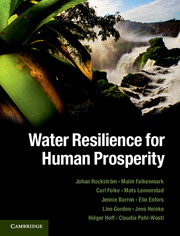Book contents
- Frontmatter
- Contents
- List of Contributors
- Preface
- Introduction to the book
- Acknowledgements
- Part I A new perspective
- Part II Living in a human-dominated world
- 2 Human modification of the Earth System
- 3 Balancing on a threshold of alternate development paths: regime shift, traps and transformations
- 4 Crucial functioning of and human dependence on the global water system
- Part III Food production globally: in hotspot regions and in the landscape
- Part IV Governance and pathways
- Glossary
- Index
- References
4 - Crucial functioning of and human dependence on the global water system
from Part II - Living in a human-dominated world
Published online by Cambridge University Press: 05 August 2014
- Frontmatter
- Contents
- List of Contributors
- Preface
- Introduction to the book
- Acknowledgements
- Part I A new perspective
- Part II Living in a human-dominated world
- 2 Human modification of the Earth System
- 3 Balancing on a threshold of alternate development paths: regime shift, traps and transformations
- 4 Crucial functioning of and human dependence on the global water system
- Part III Food production globally: in hotspot regions and in the landscape
- Part IV Governance and pathways
- Glossary
- Index
- References
Summary
The analysis in this chapter goes deeper into the core functions of the global water system (GWS), the role of water as the bloodstream of the biosphere and the key interactions between scales, including remote linkages or so-called teleconnections. It discusses how various changes in the Earth System could slowly make the GWS less resilient to shocks such as droughts, the key role of bidirectional interactions between water, land and vegetation, and local, regional and planetary boundaries. The chapter highlights three large-scale interactions that indicate long-term responses by the socio-ecological system to land-use changes in terms of so-called tipping points. It finally presents a comparative analysis of water and food security for a number of large river basins in Asia, Africa and South America.
The role of water as the bloodstream of the biosphere
Based on the principles outlined in Chapter 2, this chapter focuses on the roles of water as, at the same time, a state and a control variable in the GWS, interlinking different components and regions within the Earth System. We look at the different drivers of change, and how they affect water and water-related impacts and feedbacks as well as resilience at all scales.
The chapter first describes the role of water in biomass production and in all ecosystems, making it the ‘bloodstream of the biosphere’. Water links the different sub-systems of the Earth System through the different components of the hydrological cycle: evapotranspiration, advection, condensation, precipitation, infiltration, groundwater recharge and runoff (see Figure 4.1).
- Type
- Chapter
- Information
- Water Resilience for Human Prosperity , pp. 94 - 140Publisher: Cambridge University PressPrint publication year: 2014



